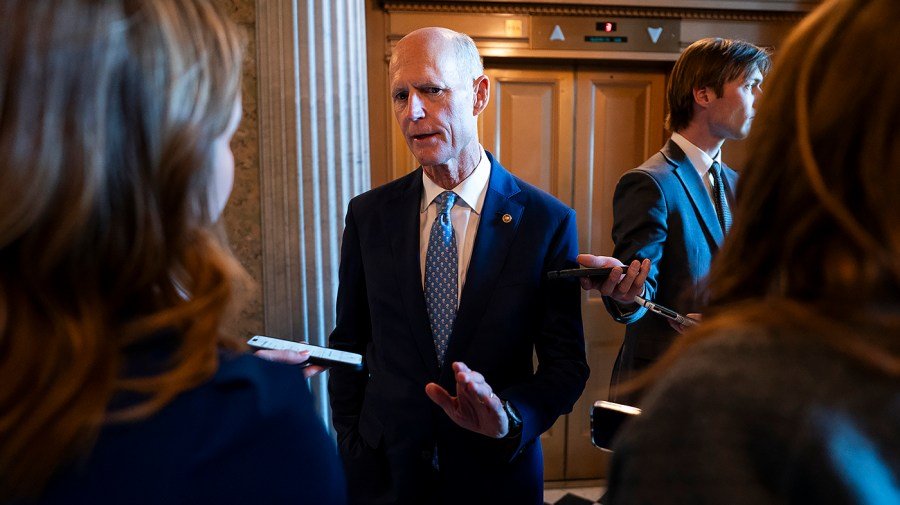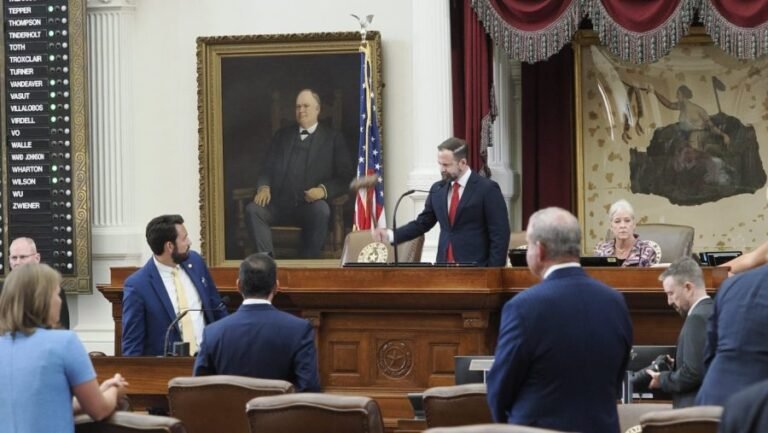
Rifts are emerging between Republicans over how to approach next month’s government funding fight, with some pushing for leaders to try to pass new full-year spending plans and others already expressing openness to another funding patch if it means less spending.
When lawmakers return from their monthlong recess in September, they’ll have just weeks before an end-of-month deadline to keep the government funded or risk a shutdown.
Lawmakers acknowledge they’ll likely need a stopgap funding bill, also known as a continuing resolution (CR), to keep the government open come October and buy time for Congress to strike an overall fiscal 2026 spending deal.
But some conservatives have already expressed backing for a full-year CR that would mostly lock in for another year funding levels set in March 2024.
“Number one, here’s my order, pass the budget,” Sen. Rick Scott (R-Fla.) said last week. “Number two, no government shutdown.”
“Number three is, if we’re gonna have a CR, let’s do a full year,” he told The Hill, adding, “If we can’t get it done by now, we’re not gonna get done anytime soon.”
It’s become typical for Congress to pass short-term funding patches in September that temporarily keep spending at current levels into November or December as they work out a larger bipartisan deal to fund the government. That deal, which has often led to a massive spending bill known as an omnibus negotiated by House and Senate leaders, enrages conservatives who complain most lawmakers are left out of the process.
Scott pushed back against that path, which he argued could lead to a “busted up, blown-out spending bill.”
His comments come after House Freedom Caucus Chair Andy Harris (R-Md.), who is also a GOP spending cardinal, floated another “yearlong CR” as an option when pressed about the fiscal 2026 process, arguing Democrats are “not going to negotiate in good faith” when it comes time to hash out a bipartisan spending deal.
“I have no problem with yearlong CR, it keeps spending at current levels, it doesn’t increase spending,” he said before the House recessed in late July.
“Just get it all over with. Just do a full-year CR, and I personally think that you could put the community project funded projects in it. We could do that if we had to,” he said. Lawmakers on both sides have been hopeful of striking a deal to include funding for projects back home, also known as earmarks, that didn’t make it into the March full-year CR.
But lawmakers on both sides are wincing at the thought of a full-year funding patch, particularly as the government operates under its third continuous stopgap. The last stopgap was passed in March, to extend funding for six months until the end of the fiscal year.
“It’s terrible because conservatives should be fully against it, because it continues Biden spending,” Sen. Bernie Moreno (R-Ohio) told The Hill last week. “So there’s no Republican that should want that.”
“It’s important to have our priorities in there so I’m hopeful that we get it done,” he said, while noting the Senate Appropriations Committee’s passage of eight funding bills out of committee so far, and plans to pass the final four after lawmakers return from recess.
“That sets us up either for passing all twelve, which would be phenomenal, or a temporary CR that would let us kind of finish the process,” he said.
Some Republicans have already expressed concerns in recent months about defense programs being put on another CR past September. Defense hawks were already upset about the Pentagon being put on a full-year stopgap for the first time ever earlier this year.
Asked about the prospect of defense programs running on another full-year CR, House Appropriations Chair Tom Cole (R-Okla.) didn’t rule it out last month.
“We could stumble into that,” he told The Hill. “It’s not a good thing, but we could certainly do it. That’s not a preferred objective. But if people aren’t willing to come to a deal with the president, then that’s better than a shutdown.”
The top GOP appropriators in the Senate and House are both pushing to pass as many of the 12 individual fiscal year 2026 funding bills as they can, and Republican leaders in both chambers have backed those efforts. But it hasn’t been easy.
Last week, the Senate passed its first batch of three funding bills for fiscal 2026, approving more than $180 billion in discretionary funding for the departments of Veterans Affairs and Agriculture, the Food and Drug Administration, military construction, legislative branch operations and rural development.
But plans to pass the annual Commerce and Justice departments funding bills were scuttled over Democratic resistance to the Trump administration’s relocation plans for the FBI’s headquarters.
The House, meanwhile, has passed two of its 12 spending bills. And negotiators will still need to iron out differences between the House bills, which skew far more conservative, and the Senate versions, which have to be written to get some Democratic support.
At the same time, bipartisan government funding negotiations are being complicated by moves by the White House to claw back already allocated funds and White House budget chief Russell Vought’s comments last month that the process should be “less bipartisan.”
Democrats have raised concerns about continuing to work through the regular appropriations process with their Republican counterparts in the face of an administration that has undertaken a sweeping operation to shrink parts of government without congressional approval.
Sen. Chris Murphy (D-N.J.), a senior appropriator, told reporters last week that he doesn’t “understand how we can trust that any of the agreements we make are going to be adhered to by an administration that is acting illegally every single day.”
“I don’t know that any guarantee that the President makes is something you can take to the bank, but the deal would have to be cut with the administration who’s engaging with the illegality,” he said.
At the same time, members on both sides see progress in the annual appropriations process as key to preventing a full-year stopgap in the coming months.
“Every bill we pass reduces the risk of having to have a shutdown or CR,” Sen. John Hoeven (R-N.D.), a spending cardinal, said last week, adding that appropriators are “trying to avoid” another full-year CR as they ramp up annual funding work.
“People have got to come to grips with the idea that the administration is going to do what they’re going to do, and members of the Congress either engage in the appropriations process, do it through regular and get this done, or they have no say in how this goes,” he said.
“But the idea that there’s never going to be another rescission or something else the Democrats don’t like, that’s how it goes. We have a Republican administration,” he said. “But to sit out the process because of it is like taking your ball and going home because you don’t like how the game’s going.”
The Senate Appropriations Committee last week also advanced legislation amounting to more than $1 trillion in government funding for fiscal 2026. That included about $852 billion in discretionary funding for defense programs and roughly $200 billion in discretionary funding for the departments of Labor, Health and Human Services, and Education.
Appropriations Chair Susan Collins (R-Maine) said at the committee’s final meeting before recess that the panel “does plan to continue on a dual track, advancing bills on the floor and through this committee.”
And some Senate appropriators are hopeful of a package encompassing the two bills ahead of next month’s shutdown deadline.
“This is what was done in 2019,” Sen. Tammy Baldwin (Wisc.), top Democrat on the subcommittee that crafted the annual Labor-HHS funding bill, told reporters last week. The senator was referring to when lawmakers were able to pass the two bills major to both parties’ priorities, along with a CR for other agencies to prevent a shutdown, for fiscal 2019 during Trump’s first term.
“I know that’s a high goal,” she said, but she added that she thinks there’s “high interest” on the House side in “having appropriations and not continuing resolutions, particularly for the Defense Department.”
“And we could create a bipartisan momentum, if you will, getting those bills across the finish line,” she said.
Mychael Schnell contributed.


